Mayfield and Five Ashes
Mayfield and Five Ashes is a civil parish in the High Weald of East Sussex, England. The two villages making up the principal part of the parish lie on the A267 road between Royal Tunbridge Wells and Eastbourne: Mayfield, the larger of the two villages is ten miles (16 km) south of Royal Tunbridge Wells; with Five Ashes being 2.5 miles (4 km) further south.[3]
| Mayfield and Five Ashes | |
|---|---|
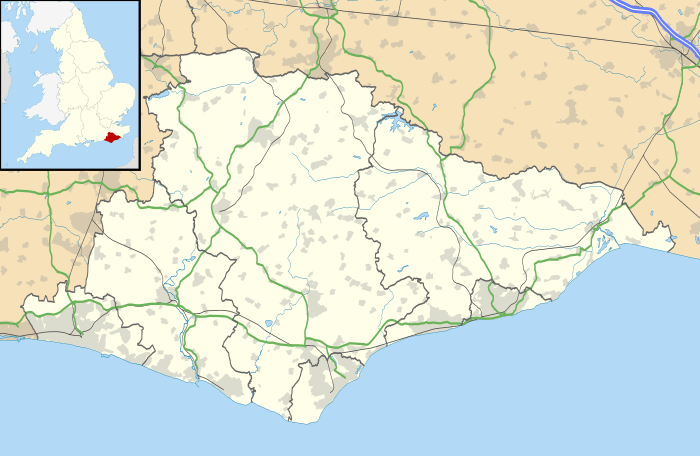 Mayfield and Five Ashes Location within East Sussex | |
| Area | 42.4 km2 (16.4 sq mi) [1] |
| Population | 3,718 (Parish-2011)[2] |
| • Density | 218/sq mi (84/km2) |
| OS grid reference | TQ585269 |
| • London | 37 miles (60 km) NNW |
| District | |
| Shire county | |
| Region | |
| Country | England |
| Sovereign state | United Kingdom |
| Post town | MAYFIELD |
| Postcode district | TN20 |
| Dialling code | 01435 |
| Police | Sussex |
| Fire | East Sussex |
| Ambulance | South East Coast |
| UK Parliament |
|
| Website | Parish Council |
Mayfield village
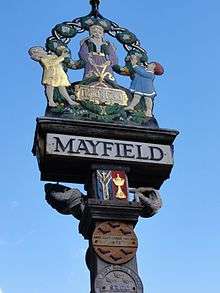
Every September the village hosts its annual carnival. This is to commemorate the Protestants being condemned here on 23 September 1556, and being burnt at the stake in Lewes.[4] The festival is part of the Sussex bonfire tradition of marking the discovery of the Gunpowder Plot. The procession marches through the village by torchlight on the third Saturday in September, climaxing with a firework display in the recreation ground. The money raised through the street collection is spent on charities.
Governance
Mayfield and Five Ashes Civil Parish falls within the electoral ward simply called Mayfield. The population of this ward at the 2011 Census was 2,614.[5]
Toponymy
The early village was recorded in the Domesday Book of 1087 within the Rape of Pevensey as Mesewelle,[6] which may indicate a well on tableland or more likely "belonging to Meese", a Norman man's name, or less likely, a new well or well dedicated to the Virgin Mary. The meshing of Norman French and Anglo-Saxon into Middle English meant that one person was often referred to by several spellings in a lifetime. Various spellings of Meese include Meece, Mese, Mece, Mees, Mey, and May.
The village name derives from both "Maghefeld"[7] (a field where mayweed grows) and "maid's field"–the village sign depicts a maid.[8] A number of 15th century emigrants to the new world had the surname May rather than Maid, which indicates the Middle English "mayde" in signage began as a rebus. Mayfield used to be a part of the manor of Malling, to the north west of Lewes, which belonged to the Kings of Wessex. Between 823 and 836 CE, King Egbert of Wessex and his son Æthelwulf gave it to Canterbury Cathedral: it became an Archbishop's 'peculiar' in the Diocese of Canterbury, and one of the Archbishop's palaces was built here. It was transferred to the Diocese of Chichester in 1846.
16th and 17th centuries
Mayfield was at its height during the boom in the Wealden iron industry, and many of the fine houses date from that time.
18th and 19th centuries
During the early 18th century, Mayfield became a centre for owling - smuggling wool for brandy and silk. Gabriel Tomkins was the leader of the local gang: in 1721 he was chased from Burwash to Nutley and then was arrested. The gang had a reputation for not using violence; and also applying their profits to the benefit of the local community, unlike many other such gangs: the Hawkhurst Gang in particular.
The Swing Riots affected the area with army arriving on 15 November 1830. Some local workers were imprisoned or transported.
With the opening of the railway line in 1880 between Hailsham and Tunbridge Wells a railway station was built to serve the village. On 1 September 1897, there was a railway accident on a curved section of track between Heathfield and Mayfield near Clayton Farm. A six-carriage train pulled by the engine Bonchurch was derailed and the driver was killed.[9] the station closed in 1965 following the Beeching Report. The station building in Station Road is now converted to a private house and the route of the railway is now occupied by the re-routed A267 bypass of the village.
Mayfield churches
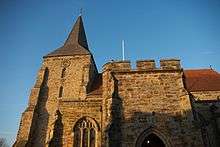
Both village and church are said to have been founded by the Archbishop of Canterbury, St Dunstan, in 960 CE, and there are legends surrounding his connection with the village. Dunstan is supposed to have become an ironworker and run a small forge next to the church. The legend goes that he was confronted by the devil, either making offensive remarks, or disguised as a young woman.[10][11] He then pinched the devil's nose with the tongs. The devil then fled to Tunbridge Wells and doused his burnt nose with the spring water.[12][13] Some sources note that the story happened in Glastonbury rather than Mayfield, and that Dunstan may have in fact clamped tongs around someone's nose, with the story of it being the devil added later.[10]
The Anglican church is dedicated to Dunstan. In 1389 much of the village and most of the church were destroyed by fire; the latter was struck by lightning in the 17th century.[14] The church was subsequently rebuilt in the fifteenth century. The church is in a mostly Perpendicular style and has a "squat, shingled broach spire".[13] Inside the church there are a number of graves made of iron for the families of Mayfield's ironmasters.[8]
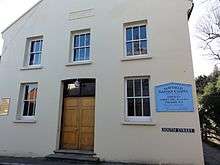
There are three other religious buildings in Mayfield:[15] the Roman Catholic church of St Thomas of Canterbury (in Station Road), Coggins Mill Church[16] (a Free Church, also in Station Road), and Mayfield Baptist Chapel (on South Street).
Shops and businesses
There are a large number of shops and other commercial properties in Mayfield High Street.[17]
There are two pubs in Mayfield: the Middle House (in the High Street) and the Rose and Crown (in Fletching Street).
Mayfield schools

St Leonards-Mayfield[18] Roman Catholic girls' boarding school, which has existed since 1872,[19] is situated on the High Street. The school consists of years seven up to thirteen. The head mistress is Miss Antonia Beary. The school is on the site of the Mayfield Old Palace which, after being founded by St Dunstan, used to be a lodging place for archbishops before being given to Henry VIII.[20][21][22] It was rebuilt in the fourteenth century by Archbishop Simon Islip, and was owned by Thomas Cranmer before being given to Henry VIII in 1545. It was also used by Edward I and Queen Elizabeth I.[13] After this, it fell into ruin[23] but was purchased in 1863 by the Duchess of Leeds and given to the Society of the Holy Child, who established a convent there. The school was opened in 1872.[8]
Mayfield College, a now-defunct boys' boarding school run by the Xaverian Brothers, was located in nearby Little Trodgers Lane. Following its closure its main building, designed by E. W. Pugin, has been converted to luxury apartments.[24][25]
The village's Church of England primary school is mainly Edwardian but has modern additions.[26]
Five Ashes village
Between Mayfield and Heathfield lie two small hamlets: Cross-in-Hand and Five Ashes. The latter is part of the same parish as Mayfield.
Churches
The small village church is dedicated to The Good Shepherd.
Commercial businesses
There are no retail shops in the village apart from a Porsche car dealership. There is also a pub called The Five Ashes Inn.
Schools
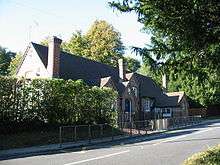
There are two schools in Five Ashes. Five Ashes Primary School is a small voluntary controlled Church of England school with around 45 children on roll.[27] Skippers Hill Manor Preparatory School is a small private school founded in 1945 by Ray and Maureen Ward, remaining in the family until it was sold to Bellevue Education in 2010.[28]
Parks and recreation
In Five Ashes, there is a large playing field where football and other games can be played and a skateboarding park. Adjoining the playing field and village hall is a children's playground.
In Stonehurst Lane, there is a park with wooded areas and ponds called Foxes Copse where dogs can be walked.[29]
Argos Hill
Rising about 7 miles (11 km) south of Royal Tunbridge Wells, Argos Hill is between the villages of Rotherfield and Mayfield. It is known for the landmark of Argos Hill Windmill, a grade II* listed building that was built between 1831 and 1843 and operational until 1927.[13] It was restored in the 1960s, and was under threat of demolition in 2008.[13][30][31] In 1939 Counties Ship Management renamed the cargo ship SS Canadian Constructor "Argos Hill".
See also
- Walter Gale, the first schoolmaster of the primary school in Mayfield (now Mayfield Church of England Primary School)
References
| Wikimedia Commons has media related to Mayfield and Five Ashes. |
- Eva Margaretta Bell-Irving (1903). Mayfield: the story of an old Wealden village. W. Clowes and sons, limited. Retrieved 18 January 2011.
- "East Sussex in Figures". East Sussex County Council. Retrieved 26 April 2008.
- "Civil parish population 2011". Retrieved 8 October 2015.
- "Maps showing location of two villages within the parish". Archived from the original on 17 June 2008. Retrieved 27 March 2008.
- "The Village Reference:Mayfield: St. Dunstan and the Devil". Archived from the original on 29 April 2008. Retrieved 28 March 2008.
- "Mayfield Ward population 2011". Retrieved 11 October 2015.
- http://domesdaymap.co.uk/place/TQ5827/mayfield/
- History of the Deanery of South Malling
- Darby, Ben (1986). Journey through the Weald. pp. 69–70. ISBN 0-7090-2586-6.
- Gray, James S. Victorian and Edwardian Sussex from old photographs. ISBN 0-7134-0131-1. image 165
- Savidge, Alan (1975). Royal Tunbridge Wells. pp. 11–12. ISBN 0-85936-040-7.
- "Europeana image description". Archived from the original on 7 August 2011. Retrieved 9 June 2011.
- Woodford, Cecile (1972). Portrait of Sussex. pp. 96–97. ISBN 0-7091-3026-0.
- Cleland, Jim (1985). The Visitor's Guide to Sussex. pp. 78–79. ISBN 0-86190-139-8.
- Church of St Dunstan, History of Church Building Archived 5 January 2009 at the Wayback Machine.
- "The Churches of Mayfield". Archived from the original on 17 June 2008. Retrieved 28 March 2008.
- Village Directory
- Homepage of St Leonards Mayfield school
- Gabbitas Educational Consultants (July 2004). The Independent Schools Guide 2004-2005: A Fully Comprehensive Directory. Kogan Page Publishers. p. 359. ISBN 978-0-7494-4164-7. Retrieved 18 January 2011.
- George Isham Parkyns (1816). Monastic and baronial remains: with other interesting fragments of antiquity, in England, Wales, and Scotland ... Printed for Longman, Hurst, Rees, Orme, and Brown. pp. 88–90. Retrieved 18 January 2011.
- "St Leonards Mayfield School - History of the School". Archived from the original on 22 May 2011. Retrieved 18 January 2011.
- Armstrong, J. R. (1961). A History of Sussex with Maps and Pictures. p. 32.
- Gray, James S. Victorian and Edwardian Sussex from old photographs. ISBN 0-7134-0131-1. image 91
- Weston Homes restores Mayfield College to its former glory
- Country life, 2008, p. 54, retrieved 18 January 2011
- "Mayfield CE Primary School". Archived from the original on 6 February 2008. Retrieved 28 March 2008.
- "Five Ashes Church of England Primary School". East Sussex County Council. Retrieved 25 September 2011.
- "School report on Skippers Hill Manor Preparatory in Mayfield - A+ Education magazine Spring 2014". Sussex Life. 9 April 2014. Retrieved 11 July 2015.
- Sussex Mills Group: Argos Hill Mill
- Friends of Argos Hill Windmill